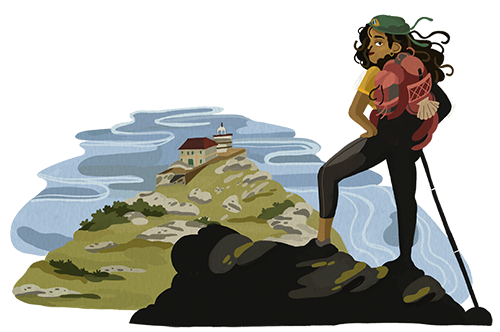extension of the way to fisterra and muxía
He who goes to Compostela
May or may not complete the pilgrimage
Whether they travel or not to Finisterre
(Traditional song)
The WAY TO FISTERRA AND MUXÍA is the natural westward extension of the French Way. It leads to the ancient end of the world, nestling on the Atlantic headland which in the late 19th century received the somewhat gruesome name of the Death Coast.
It is therefore the only way of Saint James that does not lead to Santiago de Compostela. Instead, the departure point is the city itself for a route that attracts some 50,000 pilgrims each year.
The symbolism associated with the end of the world has turned this outlying territory into a legendary land, with various tales that have attempted to incorporate it into the Christian cosmovision in myriad forms of worship: the miracle of the appearance of the Virgin before Saint James in Muxia; the tale of the disciples of the Apostle Saint James that travelled to Duio (Fisterra) to ask the Roman legate for permission to bury him; the collapse of bridge in Negreira that saved them from the hot pursuit of their enemies, etc.
Another legendary tale enshrouds the cult of the mysterious hermit Saint William, who lived on Cape Finisterre and who lent an air of holiness to the pagan fertility rituals.
A pilgrims’ hospital was founded in Logoso (Dumbría) in the 12th century, and several others were built along the way during the Later Middle Ages. Numerous testimonies exist of pilgrims that made the pilgrimage to Fisterra and/or Muxia from the 14th century onwards.
 Do not be mistaken for the Wise Man Frestón, a sworn enemy of Don Quixote, or the Magician Hermogenes, whose evil ways sought the downfall of the Apostle Saint James: the route to the End of the World is not just another Way of Saint James, but an extension that begins in Santiago de Compostela. Following it in the wrong direction from end to start is for simpletons and bigots.
Do not be mistaken for the Wise Man Frestón, a sworn enemy of Don Quixote, or the Magician Hermogenes, whose evil ways sought the downfall of the Apostle Saint James: the route to the End of the World is not just another Way of Saint James, but an extension that begins in Santiago de Compostela. Following it in the wrong direction from end to start is for simpletons and bigots.
Although the route does feature a number of challenges, such as the uphill climb at Mar de Ovellas, the route to Fisterra and Muxía presents few difficulties, and includes several stretches along tarmacked tracks, although in recent years a number of alternatives have appeared that have considerably improved the overall experience (Solpor Association).
Pilgrims are free to design each stage of the route as they wish, as the number of hostels and other accommodation options has risen considerably, allowing us to tailor the distances to our preferences and abilities.
The principal towns providing services and amenities are Negreira, Cee, Corcubión, Fisterra y Muxía. Olveiroa, Dumbría and Lires are other smaller locations, which are popular places to rest at the end of each stage.

The greatest attraction of this route undoubtedly lies at the end: the vast expanses of unspoilt sands dotted with stunning headlands that line the coastline between Fisterra and Muxía, although it also boasts monumental towns and villages such as Ponte Maceira, with its magnificent bridge, or Corcubión and its historic quarter. There are also a number of historic buildings such as Cotón Manor House (Negreira), the headquarters of the Fernando Blanco Foundation (Cee), the Church of Santa María das Areas and Fisterra Lighthouse or the Chapel of Nosa Señora da Barca in Muxía.
For hardened pilgrims, a mere four days is all it takes to complete this extension of the Way, five if the intention is to follow the triangular route from Hospital to Muxía. Those seeking to take things a little easier, or wishing to spend a day in Fisterra and another in Muxía, should plan a journey of around a week.
sections
santiago – hospital

THE SANTIAGO DE COMPOSTELA-HOSPITAL STRETCH (59.8 km)
description
As a foreigner I do not feel bonds of sentiment
And I will go
From the city
In expectation of awakening.
(Franco Battiato, Oh Sweet Were the Hours).





We leave Santiago de Compostela almost without realising it, in a gradual, discrete and surprising way. After passing by San Lourenzo oak grove, we make our way down to the River Sarela, and passing by a number of former tanneries, we enter an area of woodland.
We then head for Negreira across the delightful area of A Maía, mentioned in the poems of Rosalía de Castro, before coming to A Barcala. Here we cross the fast-flowing River Tambre over the medieval Ponte Maceira bridge.
![]()
![]()
![]()
![]()
![]()
![]()
After making a dramatic exit from Negreira under the crenelated arch of the Cotón manor house, we have a choice of two routes to Zas: the official itinerary, which goes past the Church of San Xián and a road; or a detour along a delightful riverside walk lined with trees.
A long but gentle uphill climb brings us to Terra de Xallas, a tableland used for livestock farming due to the vast expanses of pastureland. A succession of small villages lead us to the River Xallas, which we cross at Ponte Olveira across a long bridge whose origins date back to the Middle Ages.
![]()
![]()
![]()
![]()
![]()
![]()
![]()
![]()
![]()
![]()
![]()
![]()






Olveiroa is an immaculately-kept village whose livelihood depends on the Way, and a popular choice with many as the end of their second stage. It marks the end of the plains, leading us to the River Xallas, nestling between steep slopes, and then across the Buzantes Hills, the boundary with the region of Fisterra, as far as Hospital and a crossroads where we must choose to follow the way to Fisterra or Muxía.
Our suggestions
-In Sarela de Abaixo you may look back without fear of being turned into a pillar of salt and feast your eyes the Obradoiro façade for the last time – a view that is far superior to anything Monte do Gozo can offer.
-Take a well-earned rest in Augapesada before starting the uphill climb to Alto do Mar de Ovellas. It may only be 2 km long, but some of the slopes are fairly steep. At the top you will find a natural spring where the water is always refreshingly cool.
-Take the time to explore Pontemaceira, one of the most beautiful sites on this Extension. You can visit the chapel, the mills, and stop off at the local bar before going down to the riverside for a better view of the bridge.
-Just like Sleeping Beauty, Olveiroa has finally shaken off its lethargy thanks to the Way of Saint James, and today is a renovated village offering a whole host of services and amenities created just for you.
-From Olveiroa you will venture into the territory of Vákner, a mysterious monster that appeared before an Armenian pilgrim who visited the area in 1493. Try not to come face-to-face with him, or you will be lost.
hospital – fisterra





THE HOSPITAL-FISTERRA STRETCH (24.7 km)
description





Leaving the eyesore of a large carburizing factory behind us, the official way passes through an uninhabited area until we catch our first glimpse of the sea from Cruceiro da Armada Hill. The Corcubión tidal estuary stretches out before us, dotted with the Lobeiras Islands and Carrumeiros Islets, flanked by the barren granite slopes of Mount Pindo and Cape Fisterra…
A short downhill walk brings us first to Cee, a lively market town, and then to the historic Corcubión, both offering a wide range of services and amenities.
![]()
![]()
![]()
![]()
![]()
![]()
There are another two uphill climbs between Corcubión and Fisterra, passing by Estorde Beach, through Sardiñeiro, and just before arriving in Fisterra, along the vast expanse of sand of Langosteira Beach.
Finisterre has no past, present or future, for it is eternal, and eternity knows nothing of the hours or days; of pain or love; of life or death. (Camilo José Cela)






Once in Fisterra, we must continue our journey to the lighthouse before returning to the town, a walk of just over 6 km.
Our suggestions
Just like the famous Iron Cross in the province of León, on coming to the ocean, remember to cast a stone at the base of the cross that stands on Cruceiro da Armada Hill.
–Cee and Corcubión are perfect for stocking up on provisions, enjoying a snack or meal (tapas are free with drinks) or even spending the night.
-There is a choice of beaches that are perfect for basking in the sun and/or taking a refreshing dip: Estorde with its pine groves; Sardiñeiro, more urban in nature but still delightful; the sheltered and solitary Talón beach, reminiscent of a Balaeric Island cove; or the vast Langosteira beach.
-Take off your walking boots, and before entering Fisterra via the sea promenade, enjoy a barefoot stroll along the sands at Langosteira.
all about fisterra
WHAT TO DO IN FISTERRA
description






Must-dos for pilgrims
–Public shelter. If you can prove with the stamps on your pilgrim’s passport that you have completed the Extension as far as this town, you will receive the Fisterrana, the municipal pilgrimage certificate designed in 1999 by Enric Pascó.
–Sunset at the cape. Although there are alternative spots from which to admire this spectacular and free daily performance – weather permitting, of course- Cape Finisterre is the favourite with most.
Not to be missed





-A walk up to Fisterra Lighthouse, built in the mid 19th century, located 3.2 km from the town centre.
-On the way to the lighthouse, stop off at the Romanesque-Gothic Church of Santa María das Areas, which houses the 16th century polychromed figure of the Virgin Mary and the awe-inspiring and dramatic 14th century Gothic sculpture of the Holy Christ, held in great devotion by the pilgrims of yesteryear. Just like Santiago Cathedral, this church has its own Holy Door, in front of which stands a magnificent Gothic stone cross on a pillar.
-The harbour, with its numerous fishing fleet and modern auction house, the point at which all pilgrims greet one another and say their farewells.
Our suggestions






– It is well worth the extra 800 metre walk to the other side of the cape to admire the breathtaking views of Mar de Fóra Beach, a wild, unspoilt expanse of sand of extraordinary beauty. An alternative spot from which to admire the sunset.
-If you follow the ancient route to A Insua towards the lighthouse, or take the signposted detour, you will discover a site that intrigued the pilgrims of the past: the ruins of the Chapel of San Guillerme.
-Another of Fisterra’s attractions is San Carlos Castle, completed in 1767 to defend the town from its enemies and pirate attacks. Today it houses the Museum of the Sea. Francisco (poet Alexandre Nerium), the museum guide, will make your tour a unique experience.
hospital – muxía





THE HOSPITAL-MUXÍA STRETCH (23.8 km)
description
From Hospital the Way makes its way down to Dumbría, crossing the River Fragoso and the A Coruña to Fisterra road, entering the town past the Chapel of A Santiña de Trasufre.
![]()
![]()
![]()
![]()
![]()
![]()


On leaving Senande, we make our way through a large wooded area as far as Quintáns, next to the site of the former Monastery of San Martiño de Ozón.
A detour through Merexo, offering a glimpse of the Camariñas tidal estuary, brings us to Os Muíños and the monastery in Moraime, with its interesting three nave Romanesque church.
After the picturesque lead-up offered by the beaches of Espiñeirido and da Cruz, Muxía suddenly comes into sight!
Incidentally, on the entire Atlantic seaboard there is no chapel that boasts a more spectacular location or holds deeper religious significance capable of stirring the soul than the one that commemorates the appearance of the Virgin Mary before Saint James. (Hugo Rocha)
Our suggestions
– Dumbría has one of the finest hostels on the Way. This contemporary building was financed by Amancio Ortega, the owner of Zara – perhaps the name rings a bell? From there you can head for Muxía, or alternatively take the quick way back to Marco do Couto, on the main route to Fisterra.
-Legend has it that to get rid of your warts, you should take part in the religious procession of A Santiña de Trasufre, wet them in holy water from the fountain, and leave the cloth in the fountain. Many swear by this miraculous remedy, and you can always try your luck, even though your visit doesn’t coincide with the official festivity.
-Take the time to visit the Monastery of San Xián de Moraime, which boasts a church with two decorated façades. Inside you can admire the late Gothic frescos depicting the Seven Deadly Sins.
fisterra – muxía





THE FISTERRA-MUXÍA STRETCH (28.8 km)
description
From Fisterra we set off towards Muxía through Duio Valley, admiring the magnificent views of the inlet from San Martiño de Duio.
After passing through a large pine grove, we head down towards the rugged coastline, close to the windswept sands of O Rostro.
Water is the driving force of all nature. (Leonardo da Vinci)
A succession of pine groves lie between Padrís and Canosa, the village from where we make our way down to the Lires tidal estuary, the smallest of all the Galician rias. Situated halfway along the route, Lires offers a range of services.
After crossing the River Castro over Vaosilveiro bridge, the country landscape dotted with farming land and copses brings us to Morquintián.
It’s time for a climb up to Facho de Lourido hill, topped by a windfarm, stopping to admire the views of Muxía before making our way downhill to the town, nestling next to Lourido Beach.
We enter Muxía via O Coído, on the opposite side of the tidal estuary, which allows us to access Da Barca headland and the chapel.
Our suggestions
-For the love of all the saints along the Way, don’t forget to take a short northbound detour just before Padrís to O Rostro Beach. A wild landscape of unspoilt sands, boasting a superb mass of wind-blown dunes, dotted with rugged rocks. A little piece of heaven.
-If you have a special fondness for the sea, in Canosa you can take the coastal path that leads to Lires via the beach that runs along the tidal estuary. It will add an extra kilometre to your route, but is well worth the effort.
all about muxía
WHAT TO DO IN MUXÍA
description
Must-dos for pilgrims
-Visit the Town Hall (open in the morning from Monday to Friday) to receive your Muxiana, the municipal pilgrimage certificate. Alternatively, but only in the high season, you can go to the Tourist Information Office in the morning or afternoon, or talk to your host, who may be able to help you out.





-The Chapel of A Virxe da Barca is the second end of this Extension, although unfortunately it is almost always locked. Several of the seafaring votive offerings and the valuable Baroque main altarpiece were lost in the Christmas Day fire of 2013.
–Watching the sunset. The best spot has to be on the rocks next to the atrium of the Chapel of A Virxe da Barca, where the crashing waves will spray your face with saltwater.
Not to be missed
-Apart from the Chapel of A Virxe da Barca referred to above, you will also find a series of holy stones nearby that formed part of the prodigious ship that carried the Virgin Mary: the Alabar, or sail, is a flat stone that moved from one side to another; Os Cadrís, or hull, which you must pass under three times; and O Timón, or helm.
-As in Fisterra, the area around the harbour and waterfront is lined with street cafés that are popular meeting places for pilgrims.






Our suggestions
-Climb up to the top of Corpiño Hill, the highest point on the headland. Despite its modest altitude (68.4 metres), the rocky crags boast stunning views of the town and the coastline.
-Visit the eel drying factories, an ancient Galician coastal trade that today only continues in Muxía. You will find one on each side of the peninsula.
-Take a walk down to Espiñeirido Beach, an expanse of fine sands that is perfect for swimming, situated just 1 km from the centre of town.







